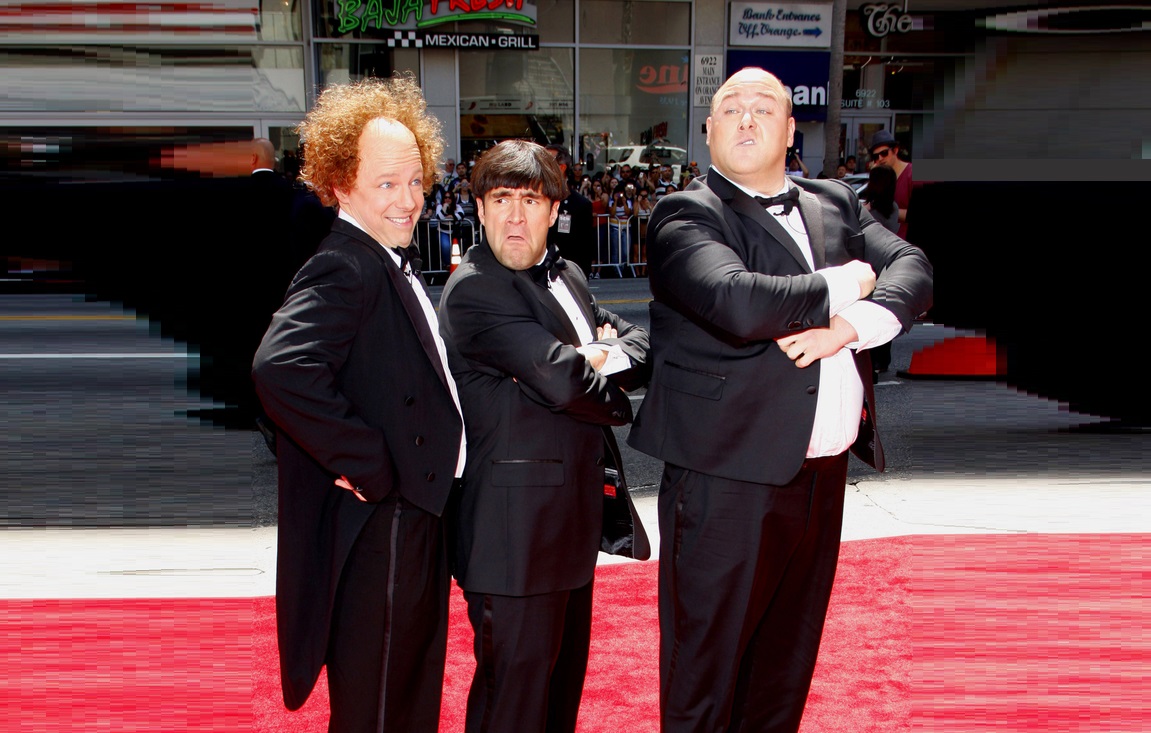
I notice that slapstick doesn’t get a whole lot of love or respect. To each everybody’s own, but I think this admittedly lowbrow form of humor gets a bad rap that it doesn’t deserve – from people who generally prefer “genuine wit” over slapstick, to those who seem to downright hate it and everything it stands for.
I want to not only come to the defense of the idea of slapstick, but also to advocate on behalf of the very best of it. When absolutely comic violence is happening to the characters on screen, are we really laughing at them for being pathetic and pitiable, or are we in fact actually laughing with them, because we root for them as they have a blast in an over-the-top adventure, and we perhaps relate to them in one small way or another?
I am going to pay special attention to my favorite form of American slapstick as done by who are, in my opinion, legends: The Three Stooges. I will also talk about some mentions of my favorite Japanese comedian Ken Shimura and the troupe he used to be a part of: The Drifters.
While I talk a lot about guys smacking each other around in creative, sometimes hysterically sadistic ways while completely bereft of cynicism, I hope you will realize by the end that this essay really isn’t solely about slapstick. In fact, this is more of an essay on showmanship and the quality of masculinity the men of slapstick and unabashedly lowbrow comedy lunge themselves into – for the sacred service of making the audience laugh. These are not pitiable creatures. They are lovable in the most sincere, optimistic of ways.
The Three Stooges
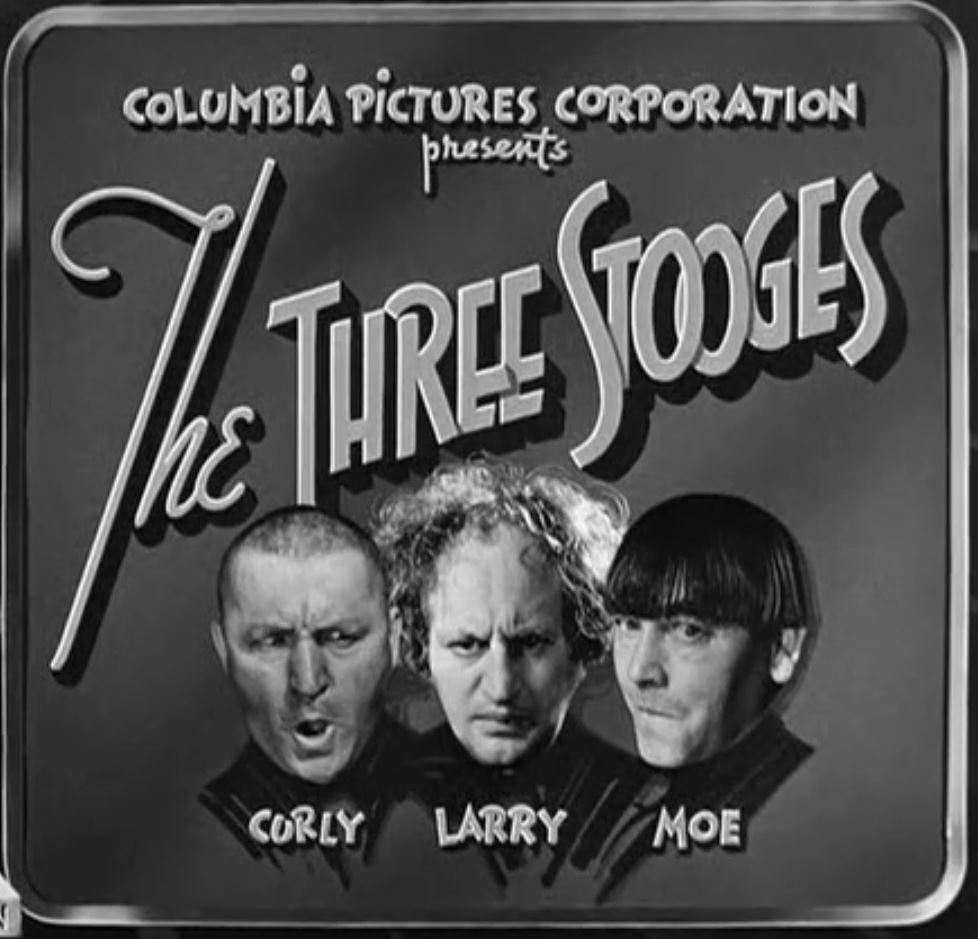
In episode 3 of Season 7 of Penn & Teller: Bullshit! entitled “Video Games”, magician Penn Jillette speaks of how children generally learn the difference between fantasy and reality very early on in their lives. Jillette says (and I paraphrase to correct a naming error on his part) when they were kids, this fantasy/reality difference was “whacked home” by Louis Feinberg and Moses and Jerome Horwitz, also known as Larry Fine, Moe Howard and Curly Howard, of The Three Stooges. According to Jillette, the Stooges laid fake violence over real love in a way that still moved him to tears of laughter. “The Three Stooges were all about outsiders sharing love and friendship through fake slapstick.”
Consider myself one of those children who had that clarified to me early on. When I was a child during the mid-‘90s I had adored a VHS tape of a collection of Stooges films: “In the Sweet Pie and Pie”, “Phony Express”, and “Playing the Ponies”. Not so long after I’ve indulged in another VHS tape (featuring Shemp Howard as the third Stooge in place of Curly) including “Vagabond Loafers”, “The Pest Man Wins”, and “Three Dark Horses”, and then an early cheap DVD including the then-already public domain shorts “Sing a Song of Six Pants” and “Brideless Groom”. I understood it wasn’t too typical of people to be into The Three Stooges at that early an age, and add to the fact I was living in Japan where no other kid I showed it to can possibly relate on a language level (though some of them did laugh at the physical comedy).
During that age, The Three Stooges (as well as the likewise old Our Gang series of films) were watched with a sense of longing on my part – that is, my longing to be a part of a “gang” of friends. Whereas Our Gang involved a pretty extensive network of friends in any given situation doing epic, mock-adult things (as well as being “relatable” as I would have been the same age as the actors as I watched back then), The Three Stooges were of course grown men always in a group of three. However, this still didn’t deter me from trying to relate to them and pretend I was a member of a couple of guys going about town just doing stuff together and being in real inseparable friendship. I may not have been able to express what I wanted out of this at the time, but I think that Penn Jillette was right on this – it really was about love and friendship.
For a long time in my recent life, I had wanted to give focus and praise to men who were unabashedly themselves in a world that can sometimes be too condescending, too highbrow for their own good, and otherwise too “high society”. Men of physical comedy often are passed over in favor of so-called “genuine wit”; while there is of course nothing wrong with such genuine wit, in my opinion it very much takes enough raw wit to come up with the sheer performance happening in something like The Three Stooges. More on men unabashedly themselves, this can extend to musicians that play a little too loud, a little too longwinded, a little too over the top; boys who skateboard on daunting places that would freak their mothers out; men in general who don’t apologize for being who they are and don’t care who knows it. This sort of thing, in my mind, is exemplified by the Stooges in what amounts to the most optimistic way.
By what is no doubt coincidence, as I was gathering my thoughts to write this, I’ve come across some harsh sentiment against slapstick on social media (For reasons of tact, I won’t divulge who says this). Apparently, slapstick has been regarded by a certain individual as follows: “All slapstick comedy is male. Humans laugh when seeing men hurt. It’s the devil.” Then some more: “Slapstick comedy is spermatic. Killing the competition to reach the egg. It’s why we laugh at it. It’s far less funny when women get bonked about.” I was left speechless by the last bit: “The devil hates God and takes great delight in seeing man (made in God’s image) ‘take a fall’”.
In my mind I was seeing these set of accusations being lobbed at what can be considered genuine heroes of mine. I say Three Stooges but I hope it’s clear by now that I am talking about four individuals: the three Howard brothers and Larry Fine. I take their optimistic presentation of themselves and their ongoing drive of never being bogged down despite every pratfall on screen, then imagine them being directly accused of whatever this guy says slapstick is all about, and I can do nothing but be livid. It had shown that my position not only seems atypical but downright at odds against a world that merely see these comedians as pitiful bumblers.
I will grant that enough media out there indeed paint men in a way that is for condescending. They are not to be rooted for, and their downfall should be celebrated, as their agenda goes. This is prevalent anywhere from the older “screwball comedies” to modern Woke fictional media in which men exist only to be trampled and berated by Mary Sues like in new Star Trek outings. But this is not what true slapstick is all about, not even close. The Three Stooges are no pushovers. In fact, they are resilient, defiant, often irreverent and iconoclastic in the best of ways, and they stand alone but together. I would rather face hell with my own gang of Stooges than serve in whatever Heaven this person above seems to prefer.
In the Sweet Pie and Pie
Since we’re on the subject of resilience, I want to explore what is still to this day among my most favorite of The Three Stooges films, “In the Sweet Pie and Pie”. There will be some spoilers here so perhaps it is best if you actually saw the film if you can find it. Or, you can just read along here.
Three sisters, Tiska, Taska and Baska Jones are to marry three convicts to retain an inheritance, a scheme cooked up by their lawyer. The convicts in question are three falsely convicted innocent men on death row, and who should they be but Moe, Larry and Curly. When we cut to the Stooges, we find out they face hanging the next day and are determined to get out and not give up. In true bizarre fashion, Curly just happens to have three large saws in his pants, and almost right away the saws get put to good (ab)use, cumulating to a fencing match between Moe and Curly. But watch – Moe’s saw goes *clear* across Curly’s head. Upon closer inspection shows that the saw Moe was using wasn’t in any way lethal, but then a closeup of the then-ruined saw was swapped in. When you think they were real saws being fenced with, for a second you’d be flabbergasted as to how Curly actually survived that with no damage.
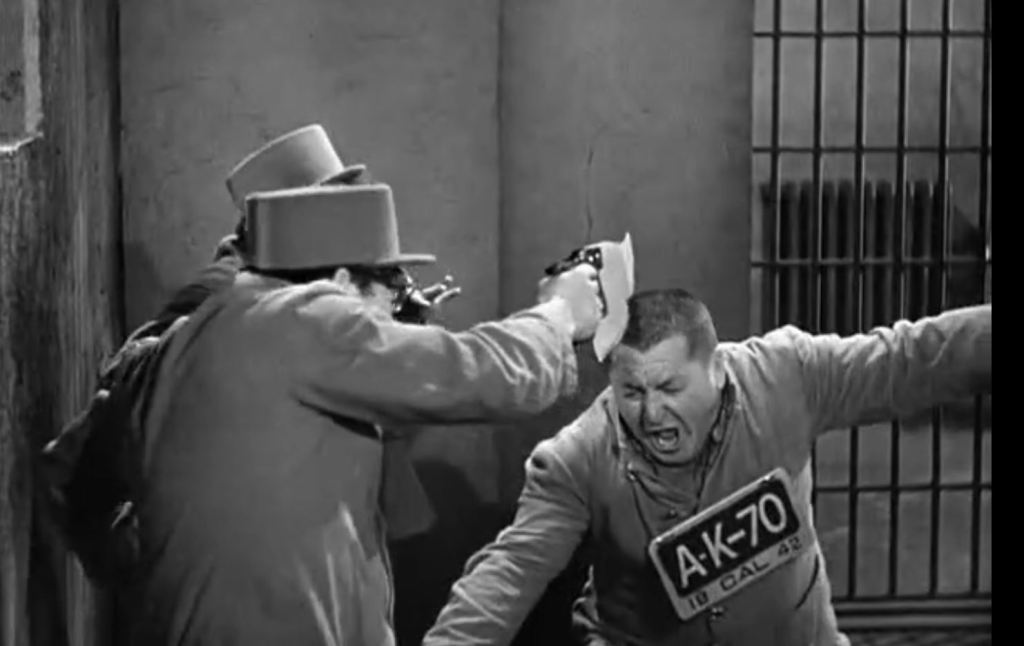
The sisters then come into the cell and they are hastily married to the convicts, and then are left immediately to rot once the deed is done. I will note the amusing moment with Moe going “No wedding kiss!” followed by him looking at Curly and they give a quick smooch.
At the start of the hanging, in truly absurd fashion complete with a sports broadcaster intending to provide a “jerk-by-jerk” description of the hanging complete with an audience of other prisoners with a vendor of snacks and a program. The hanging is botched however when the ropes break and are tangled in it. Immediately though, they get a message that the real criminals have been captured and have confessed and the Stooges have been pardoned by the governor, and they are free.
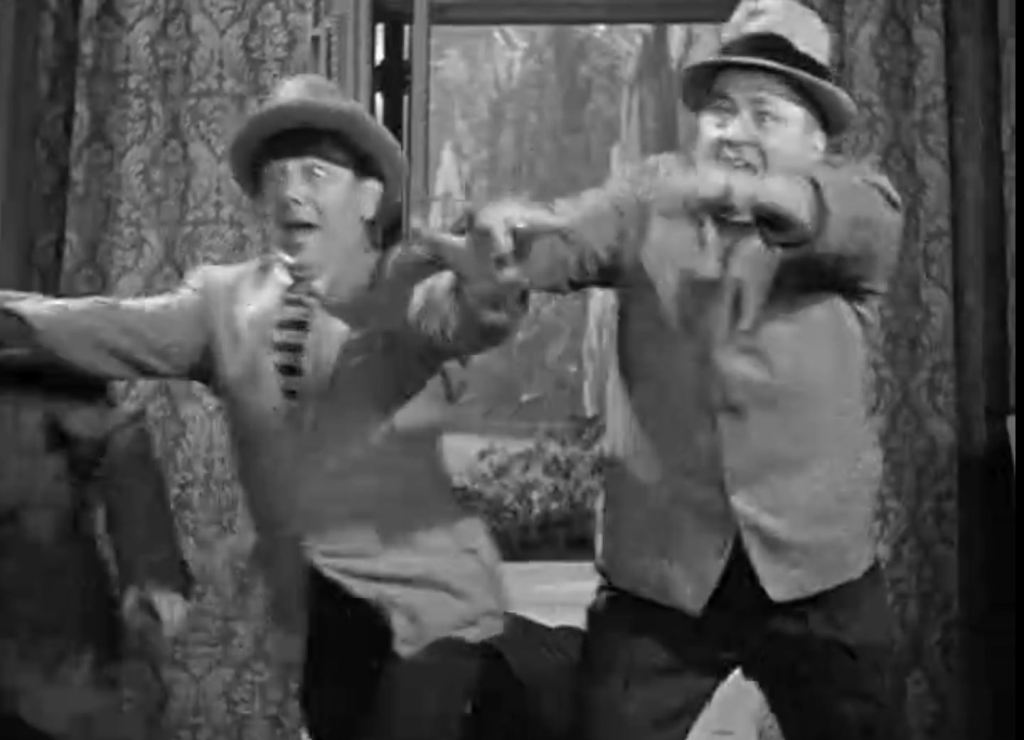
I love this next part. The Stooges, newly freed and suited, barge right in to see their newlywed wives, to which they spit out their drinks and evade them. After it gets explained that they are pardoned, the three sisters punch the Stooges in the face “just to let them know who’s going to be boss around here”. Now of course, in today’s lowbrow comedies where men are portrayed as pathetic trash, that’s all the fight we will ever expect from those men in question. But not Curly, Moe and Larry. Not for a second. “Well if that’s how it is,” goes Moe as they get up, “boy that’s how it is! Shake!”
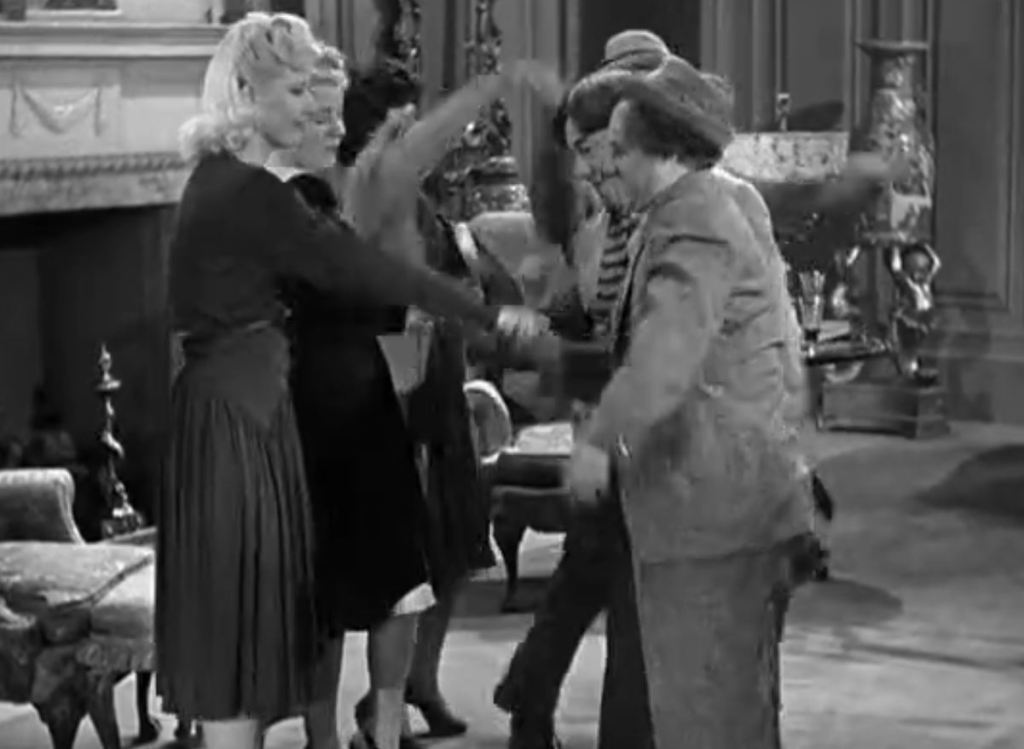
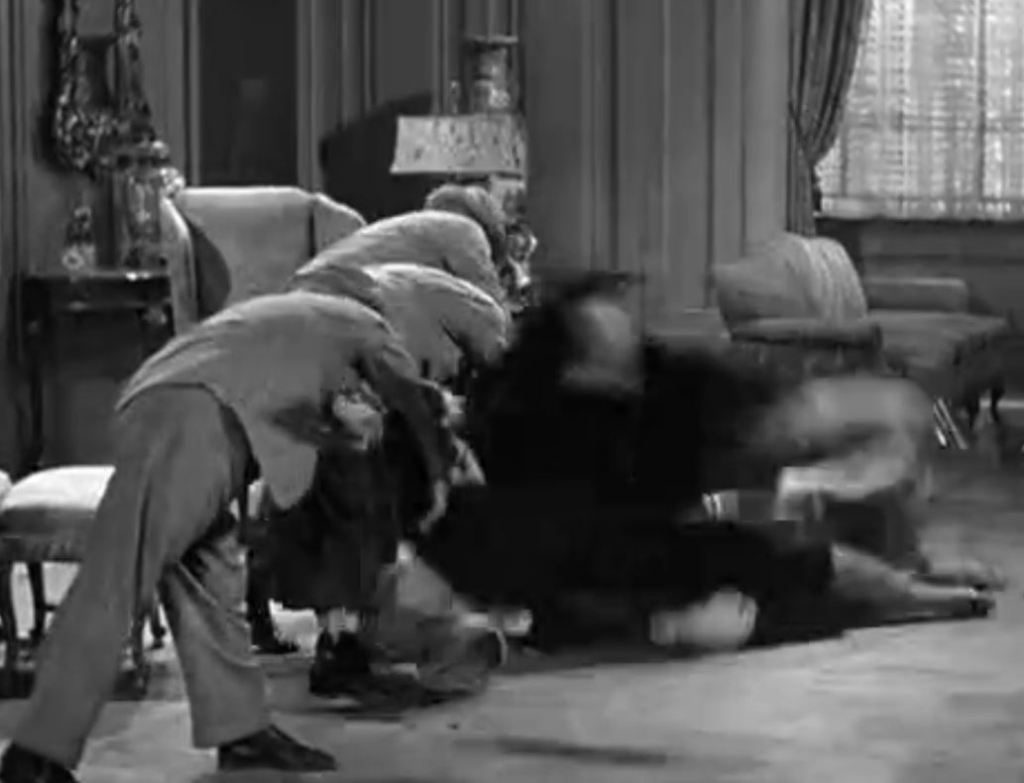
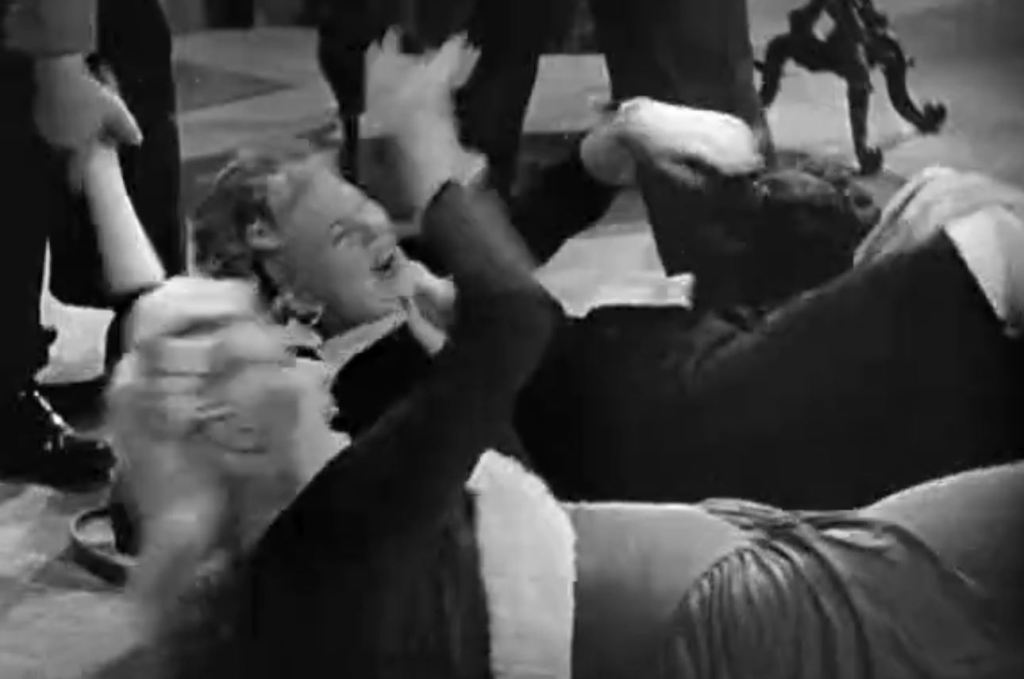
Then they proceed to toss the girls from behind their shoulders and slam them right into their own floor! Now that’s standing up for yourself! “That’s just to let YOU know who’s going to be boss around here!” says Moe. Are these the acts of pathetic men? No, I say! They’ve stuck together for their rights and were in complete “sympatico” as they asserted their dignity. How can you not love that?
Of course you realize, this means war. The sisters, desperate to get rid of their new husbands, cook up a scheme to get them signed up to as much high-society routines as possible, so as to make them fail when they get so sick of it and leave. Made aware of this, Moe stresses at night that they have to act like society now (Curly retorts hilariously: “I refuse to act that dopey!”) lest their new wives have any excuse to throw them out. And maybe this is just me being ignorant about norms of the old days or wealthy households, but it’s hilarious to me that the Stooges sleep with themselves and not with their wives. Well, I laugh at the situation of course, I don’t laugh the Stooges themselves as I’ve already explained. But the thing is they, like any given comedy gang, tend to sleep with one another like brothers. A touching concept in itself in a way, isn’t it?
There is more hysteria to be had here, as they’re still used to the “prison” way of sleeping so they are discontented with their comfy beds, so they turn their beds in to a bunk like in jail, but Curly gets stuck with very high-up top bunk. I can’t possibly convey in words how hilarious the result is when Curly manages to stack a bunch of furniture to use as a ladder and finally reaches the top bunk. You must see it, and it’s driven me to psychotic fits of laughter every time I saw it when I was little.
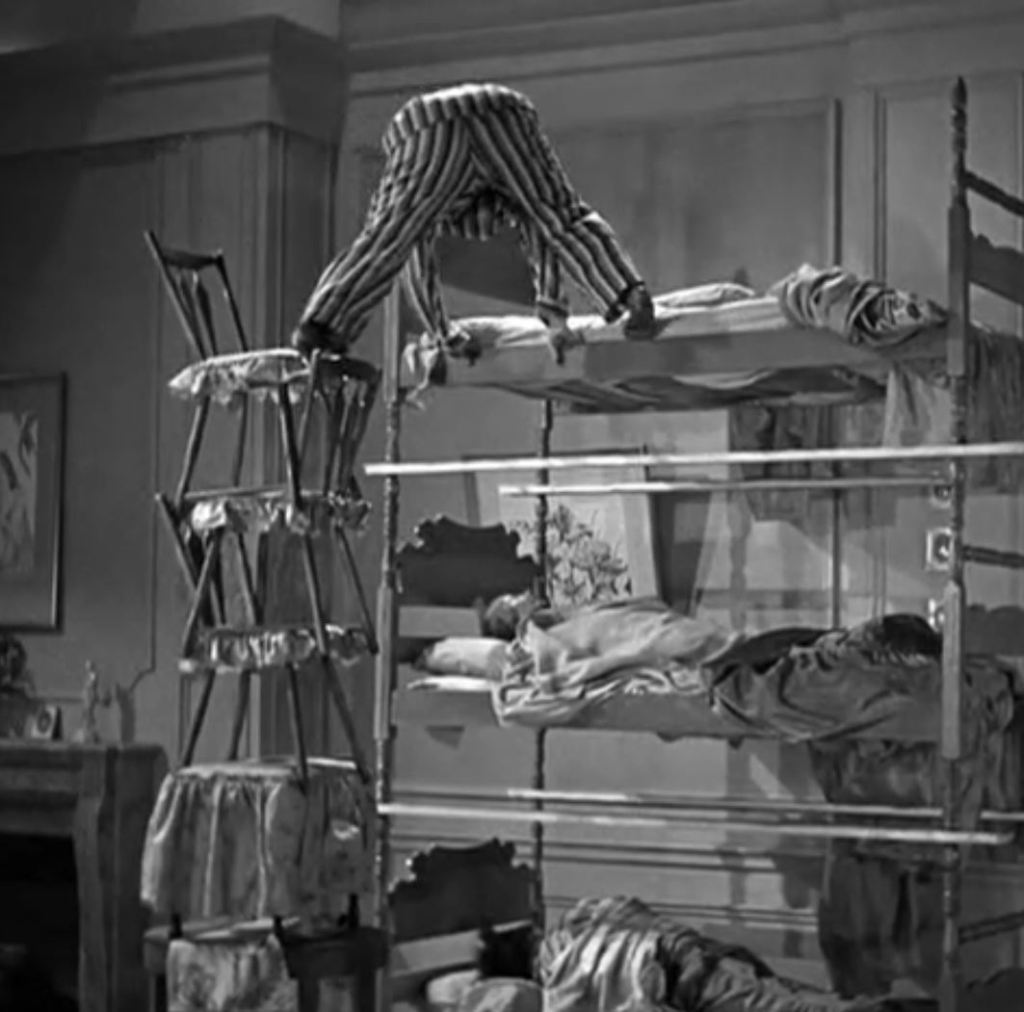
Then next the Stooges must take dance lessons, and really the following scene is reused stock footage of another episode. Before that though, there is quick bit where Curly protests doing dance lessons so early and without breakfast, but Larry retorts, “You can’t quit! That’s what they want us to do!” So this is what I read as instead of mere conformity and being pushed around, it’s the Stooges banding together to survive and resist the tyranny of their new wives. In their own silly, cartoonish way, the Stooges ultimately seem to have their own sense of dignity, even though they kick and scream their way through.
After the dance lesson footage where everybody including the lady instructor ends up out the window and into water, the Stooges are said to have undergone a grinding wheel of routines and still they persist in sheer defiance. The lawyer then proposes a party in which the Stooges will be so humiliated in front of society members that this will be untenable for them.
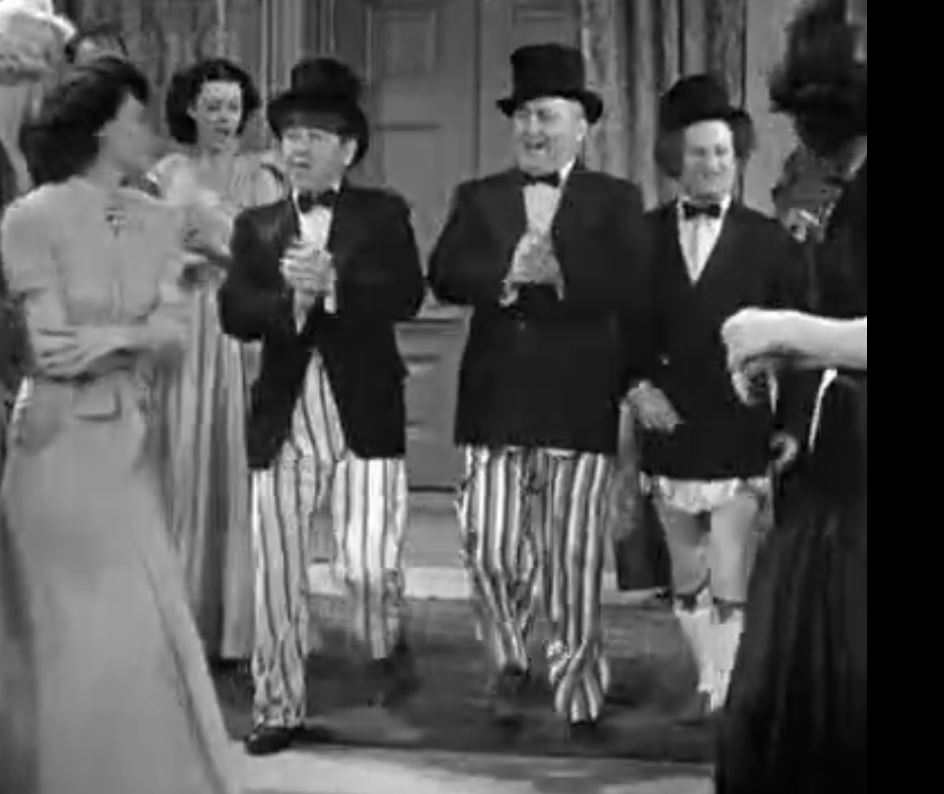
It starts off shameful enough, the stooges are in their tuxes and top hats but forget their pants and are rushed out of the party. The lawyer then bribes the butler concerning a big cake, for later.
There is some dialogue around the table that is pretty witty for the dialogue-based comedy fans out there in my opinion, though of course Larry and Curly are always punished for any given thing they say by Moe who basically acts like a grouchy big brother to them both. Moe of course is literally Curly’s older brother in real life and wasn’t the grouch he is here in fiction, so this comedic fiction of violent expression of brotherhood has a charm to it.
Then the butler with the cake returns, and pretends to trip and slam the cake upon an otherwise civil and sociable Moe. Tiska outwardly accuses Moe of tripping the butler, but the other woman there (played by Symona Boniface) defends Moe and accused the butler of doing it deliberately. Love this woman for standing up for the truth by the way; even to the point that after Moe accidentally pelted her with a piece of the cake because the butler ducked, she slammed a pie in the butler’s face because he “started it”.
And thus begins the very first proper pie fight in Three Stooges history. The Butler and the woman laugh hysterically in their delightfully childish piefight which leads into nobody, no Stooge, no man, no woman there, being potentially spared from pies in the face. There is too much to detail here that can’t be better explained than by just watching the absolute unabashed mayhem and irreverence towards high society. In the end, the lawyer walks back into the war ensuing and barks and slaps the Stooges and declared that their marriages will be annulled at once, but the wives, no doubt exasperated at the lawyer’s hair-brained scheme gone awry, join the Stooges and everyone to inundate him with pies, and thus a happy (?) ending for this film!
A Few More Words About the Stooges, and Real-Life vs Fantasy
“In the Sweet Pie and Pie” saw Moe slap, eye-poke, and bonk foreheads and guts, all of which are fairly typical in Stooges film. The same film saw Moe fling the end of a saw on Curly’s face, run the same saw through Curly’s head, drag Curly by the nose, and other more situationally appropriate punishments.
It should be obvious to the reader by now that, not even counting the over-the-top ones like with the saw, casual violence in real life is probably not the best way to go about showing fellowship. Many in the real world unfortunately inflict physical violence on others, in particular their own children, and completely excuse it with notions of “tough love” or “teaching discipline”. Remember me mentioning that mutual friend of a friend whose wife boasted about their second son’s circumcision on social media, back on my essay “On the I Don’t Remember My Circumcision Argument”? The same mutual friend of a friend had likewise boasted on the supposed benefits of whipping his first son with a belt “like his own dad did to him”, professing to be grateful for being beaten in the ass for social media clout. He must have been a tortured specimen to be sure, taking out his frustrations on his own flesh and blood and then calling it love. I don’t buy it when anyone uses this excuse.
What is it, then, that makes it love when the violence is completely fictional and completely fake?
In “Vagabond Loafers”, again in which Shemp Howard plays the third Stooge in place of Curly, Moe gets a bag of steel pipes landed on his head, Shemp falls flat on the floor from the fireman’s pole where the backseat of the Jeep should have been, Shemp accidentally blow-torches Moe’s ass, and Moe slams a pipe wrench on Larry’s head. This amounts to anywhere from comic accidents to Moe being an exaggerated grump trying to keep everybody in line where he is not always the brightest himself. Shemp thinks the “water don’t work” because pipes are clogged up with wires, which are actual electrical wires, to which Moe, allegedly the brains of the gang, initiates connecting water pipes to those electrical pipes, practically resulting in water flooding areas of the house.
In “Three Dark Horses”, Shemp takes a huge bite out of Moe’s Finger, only for Moe to bite Shemp on the nose while both grunt frantically. This resembles an over-the-top version of some squabble between two brothers (Shemp, too, is a real-life brother of Moe) who we can bet otherwise love each other’s company.
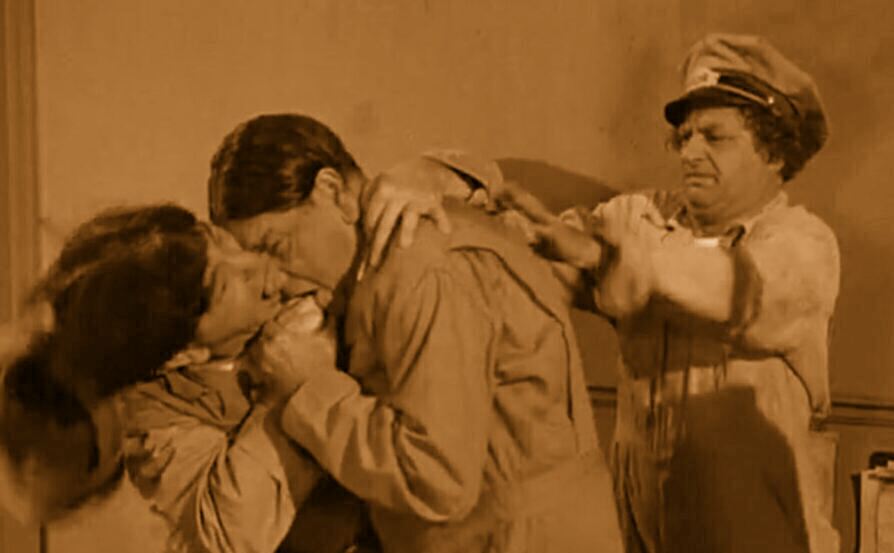
A maniacally funny scene to me is in “Pest Man Wins” where Moe, in retaliation for Larry feeding him rat poison, straight up rips out a huge chunk of Larry’s hair.
In “Sing a Song of Six Pants”, Shemp wrestles with an ironing board, smacks his own hand with the hot iron, hits Moe accidentally with a broom only for Moe to bonk him with the broom, shove the end up Shemp’s mouth and drags him away with it. Moe rewards Shemp’s ineptitude by tweaking his nose with a pair of large scissors. Moe cooks up a pancake lunch using the steam ironing press (best way to prepare them, am I right?), and later uses the same press to punish a member of a gang of crooks by pressing his head between it while Larry shoves a hot iron on his ass.
Of course, I could go on with examples like these. What is the point I’m even trying to make here?
In a past essay of mine about Representation Politics, I mentioned my theory on the purpose of fantasy – to put it succinctly, it is about envisioning an ideal sort of world and bringing that closer to reality as we can within reason. When applied to this world of love through fictional violence and fake slapstick, it’s really all about being able to let loose. When Moe inflicts punishment on his fellow Stooges, it’s not because we hate them or pity them and want to see them defeated and end up in the gutter. It’s not because we laugh at any permanent damage. In fact, if you notice, there is *no* permanent damage or barely even short term damage.
The fantasy is to do “dangerous” things and live life long range, and not actually be hurt by it. The aspect of bringing it closer to reality is really just putting it on the screen and seeing it happen with real people. It’s not that hard to figure out that some of the more dangerous-looking scenes use either dummies or stunt doubles, and Moe isn’t *really* trying to cut off Shemp’s nose with scissors. I’ve already mentioned that the saw that went through Curly’s head was also just a clever prop. But the illusion of all that, especially for a child like I used to be (and still am in many ways??), makes it for epic entertainment. People not only living life a wild way that can be nothing but envied, but doing it with some of your best friends? In a childhood in which I was constantly being marginalized for being different and friendships were neither easy to come by nor can be as epic as on the screens, I’ve dreamed and fantasized constantly of such silly, levitous adventures.
It is so strange to me to call this, essentially, the Devil’s handiwork against those created in God’s image. No, this is not the time for me to go into my thoughts about religion, but if these people think fake violence is this bad, what about men and boys that oftentimes risk real injury through skateboarding, American football, and other long-range sports? Does the thrill most of us derive from watching these men and boys in action come from our contempt of them as they smash their faces in or break their legs? No. If anything we are awed at their successes. In turn, think it’s safe to say we can be awed by how these men of slapstick make it look so easy to act absolutely bugnutty and over the top while coming out of it with a full skin and an optimistic smile.
Shimura Ken, and The Drifters
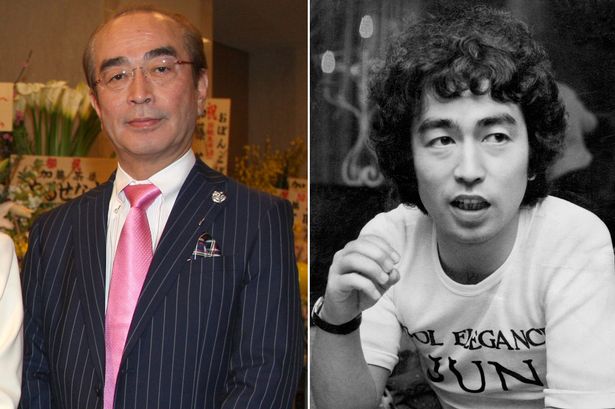
I am going to refer to Japanese comedian Ken Shimura as Shimura Ken (Surname then given name as per Japanese custom) simply because that’s precisely how I’ve internalized my personal comedic hero; please bear with me here. Otherwise I’d just be correcting my work all over the place as I proofread.
Shimura Ken, practically a legend of Japanese comedy and a household name of the country, died on March 29th, 2020. He was said to be the first celebrity to make public their diagnosis of COVID-19, and his death sent waves of shock and disbelief among the Japanese people. Ever the symbol of lighthearted persistence and active at the age of 70 with now unfulfilled plans including carrying the Olympic torch for a relay for the Tokyo Games, nobody expected him to be dead just like that.
I could talk more about slapstick as it relates to Shimura Ken and the band-and-comedy-group that he started out with, The Drifters, because there truly is a lot to say. I will keep it short, however, and will say that I fondly remember the very impromptu feeling I got from watching a Drifters slapstick performance, be it a televised stage performance on their show Hachijidayo! Zen’in Shuugou! or television. They smack around, slam objects, perturb, abuse, and “torture” in ways that, just like with The Three Stooges, are devoid of any cynicism or misanthropy. When one guy gets hit, sometimes they go something along the lines of “that one really hurt, dumbass!” and that just made things even more funny. Like I mentioned before, they make it all look so easy and exciting, and yet we as children knew it was all fiction. Any of Shimura Ken’s antics during and after his Drifters work is something most of us knew was unacceptable, from the fake violence, ultra-lowbrow humor (where due to differences in Western and Japanese standards, are even more juvenile than the Stooges), and downright gleeful perversion and suggestive jokes. (Ok, I said I’d keep it short but I’ve rambled long enough)
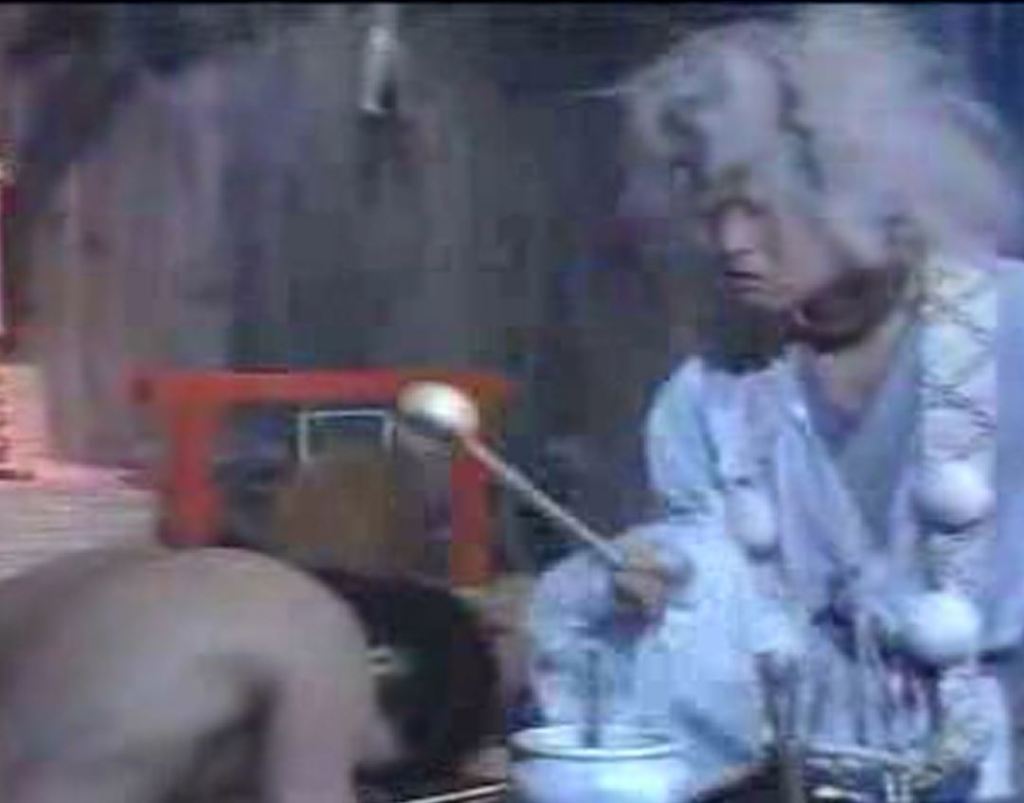
Instead I want to shift gears and talk about the showmanship of men such as these.
Being an improvisational genius must have been a requisite for anyone to be accepted into The Drifters. For one, there is the fact that they were a band and had to put on a comedic but oftentimes airtight performance (trivia: when The Beatles had their first concert ever at the Nippon Budokan, The Drifters had a very short performance as an opening act).
In Hachijidayo! it seems to me that there is a general script for any given stage performance, but allowed for a lot of improvisation, especially on the rare occasion something unexpected happens like a whole stage set falling apart or somebody catches fire. Fellow comedian and fellow Drifter Cha Kato (or “Kato-chan” joined Shimura Ken in ‘higedansu’ or “Moustache dance” routines in which they performed clever, talented acts like catching a flying orange with a sword blindfolded from a distance, or balancing a bowl of raw eggs high atop the stage with a long pole, or sillier things in which they would spin bigger and bigger buckets around with a punchline in which they get soaked by their own devices.
Aside from those regular acts, Shimura Ken and Kato-chan have other skits with just them together. A pair of consecutive skits come to mind that I really want to talk about.
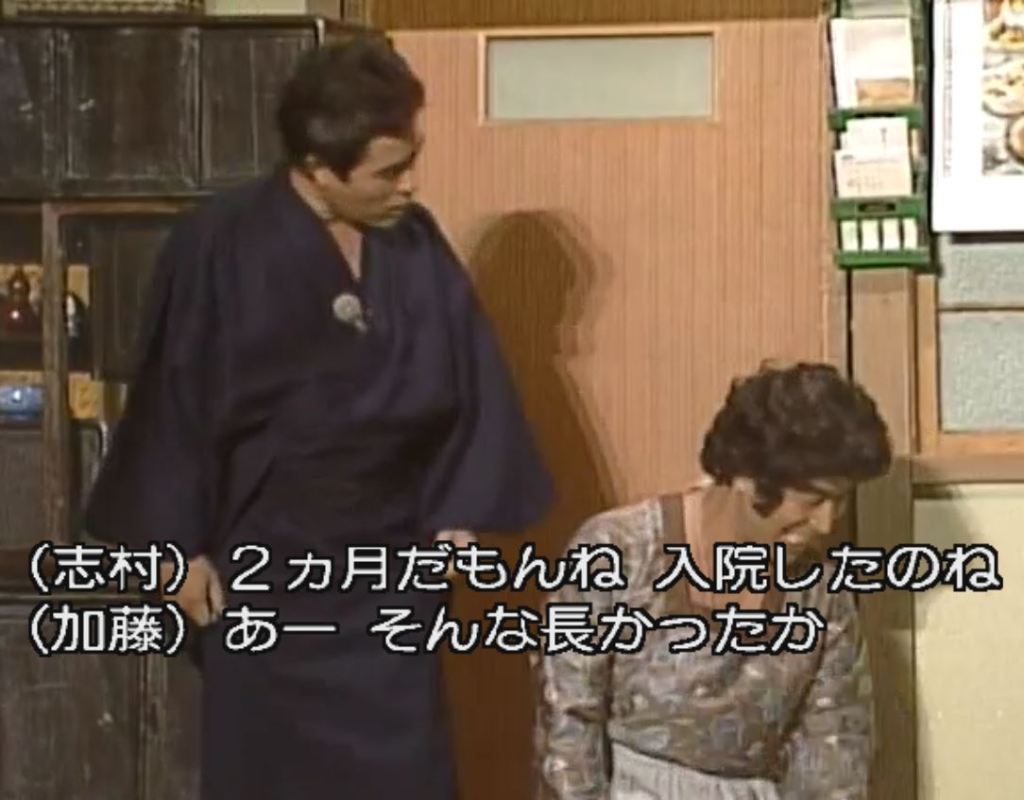
The setting is at a home where Shimura Ken, in drag, plays the housewife welcoming back home the husband, played by Kato-chan, from being discharged from the hospital. The housewife then proceeds to serve the husband a glass of milk which he accepts and takes a light sip from, but the housewife then complains that “back when you were healthy, you always chugged milk in one go! You must still be sick I’m calling the hospital right now” to which Kato-chan denies that’s necessary and proceeds to chug the milk. He then wants his curry rice dinner, and the housewife serves him curry rice and a glass a milk. “I’ve only asked for the curry,” he says. The housewife goes into the same spiel, “you always had a glass of milk with your curry! I’m calling the hospital” to which he again chugs down the milk to assure “her” everything’s ok, though he loses his appetite for the food by then.
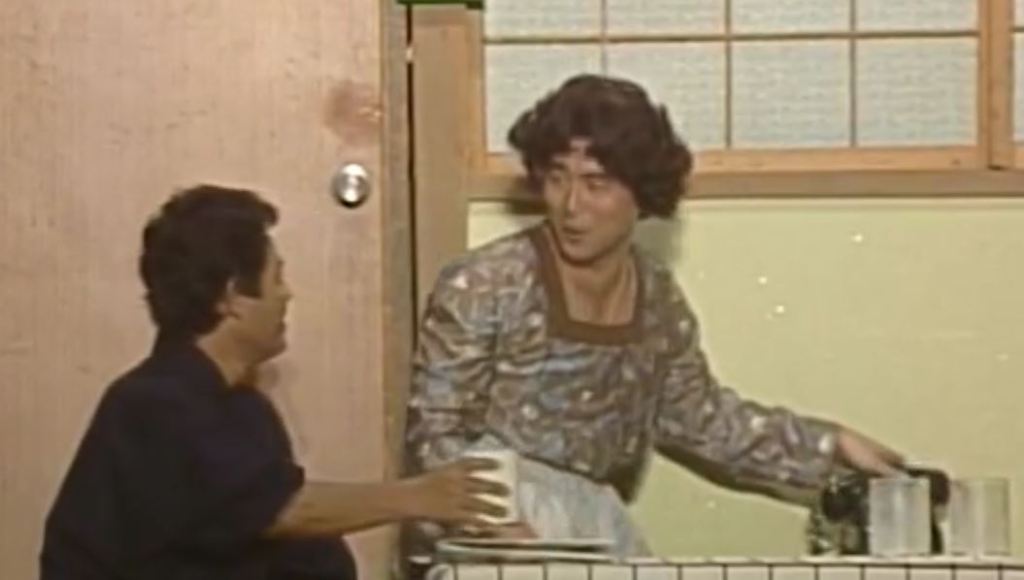
Something similar happens on and on throughout the skit with ready-made glasses of milk, from a newspaper and a milk, cigarettes and a milk, an ashtray and a milk, a telephone call and a milk, with variations such as Kato-chan tossing the milk while Shimura Ken isn’t looking, to which a new glass is immediately replaced, and Kato-chan failing to chug and spilling the contents all over himself to which a new glass is replaced again.
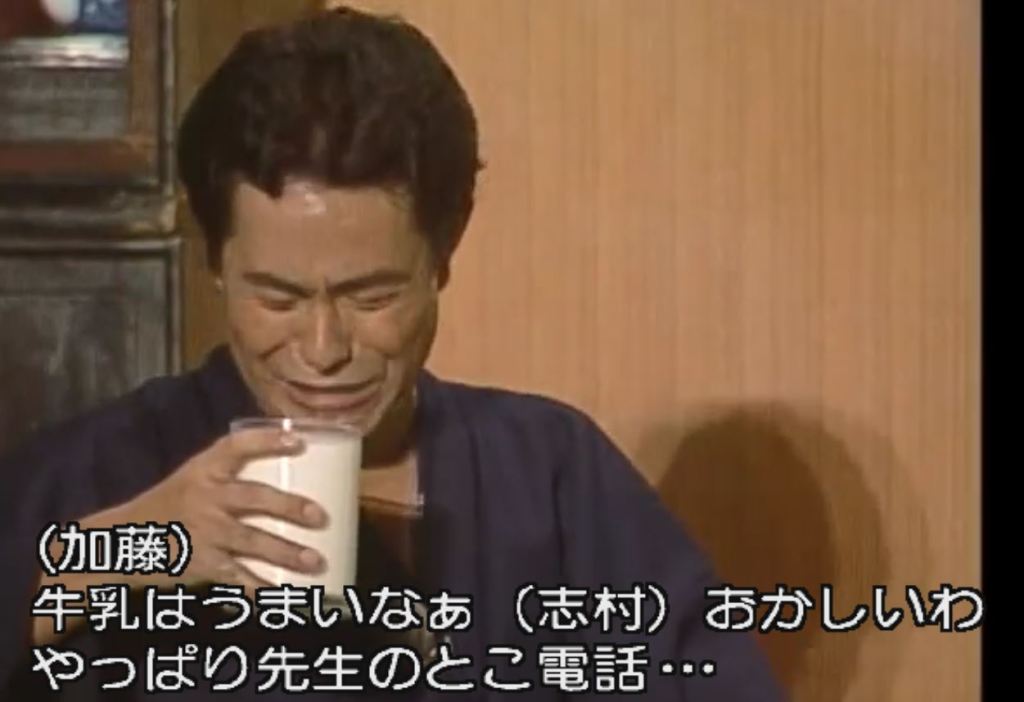
The punchline at the end is when he wants the housewife to get the futon ready for bed, with a gigantic glass canister of milk. All the while Kato-chan has been chugging what looks like real milk many many times over as part of his performance, with no tricks. At the same time I am laughing my ass off at this every time I watch it, I also think: that takes some nerve, some resolve, to carry on a skit like this with dignity.

Immediately after this skit ends, the stage crew replace the stage sets with a very brief musical intermission; Kato-chan and Shimura Ken likewise change outfits behind the scenes. When the second skit starts, Kato-chan, now in drag, runs a wanko soumen restaurant that serves thin wheat flour noodles, for those unfamiliar. Shimura Ken, actually a guy this time, is a customer walking in for some of that wanko soumen, which you can ask for as many refills as you want. Note that Kato-chan is doing this skit right after he chugged an absurd amount of milk.
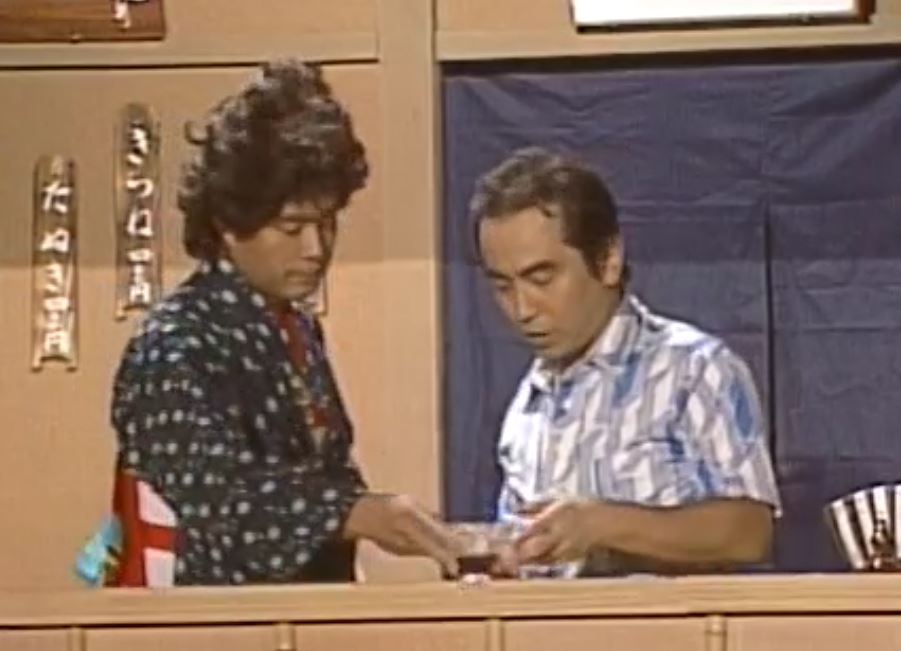
Each serving a quick meal for the hungry, Shimura Ken orders his second, then his third that Kato-chan just places a new load into the bowl. Satisfied, Shimura Ken says he is done. Kato-chan then proceeds to just toss in another load into the bowl, expecting him to eat it. The skit parodies on Japanese social norms of not wasting food, where it is more stigmatized to do so in contrast to say, the United States, where doggie bags or the downright tossing of food is considered far less of an issue. “If you’re done, please put that cap onto the bowl, please. Unless it’s capped off, I’ll just keep refilling” says Kato-chan, to which Shimura Ken acknowledges and proceeds to shove down more noodles. Right as he finishes round 4, Kato-chan shoves round 5 before Shimura Ken even gets a chance to put the lid on.
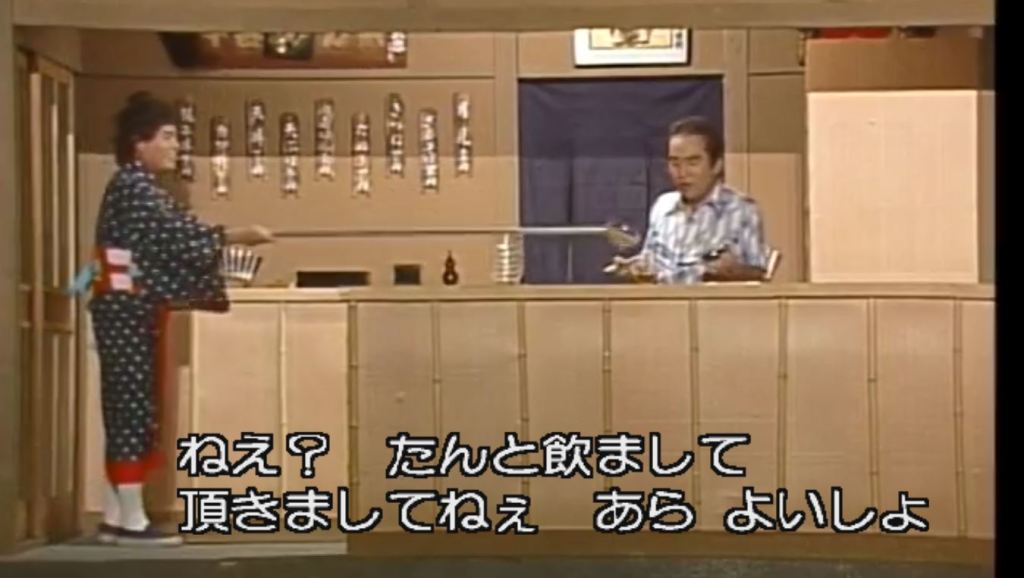
This gets more elaborate with things like using a long pole to refill after Shimura Ken shoos Kato-chan away, sneaking up from behind him, shoving noodles onto the lid while he’s not looking so he refills it himself, and such! During this Kato-chan goes, “Thank you *so much* for all that milk earlier!” That’s right, it’s revenge time. Now Shimura Ken has to shove down soumen noodles and it takes the all showmanship he’s got to carry through. After the tenth bowl he’s finally had enough and he caps off the bowl. Kato-chan says that for those who eat so much there’s a prize: a huge bowl of free soumen to take home!
It’s the kind of revenge you inflict upon your friends when you get put upon in Mario Kart or some other interactive video game such as that. It’s hilarious to see this sort of thing being performed upon each other in succession. But way large scale and fantastical, of course! Only these genuine entertainers soldiered on with some wild acts for the entertainment of the audience. And once again, they aren’t the objects of pity by the audience. The audience loves them for this banter. The kids love them, not to condescend, but as heroic evangelists of levity in a world that always seems to need it, when the silly conventions of the world need the ridicule they deserve.
Shimura Ken will be missed by myself and so many.
The Lightheartedness of Masculinity
The reason I felt compelled to write all this stems back to sentiments I’ve had when I was writing “An Objectivist’s Case for Men’s Rights Advocacy”. In a world where even a lot of defenders of men’s issues make the argument for men being a provider, self-sacrificial animal, and basically valued for only what they can give and what they will lose and what we can take from them, I’ve wanted to provide a voice for the self-interested man, the “selfish” man, and the man who achieves things because it is they who achieved it, and it is what they wanted to achieve. Another side to this is that I want to advocate for the man that is just his own honest self and doesn’t care who knows it. There is that irreverent, iconoclastic streak to this sort of man that I just have to admire; the man that mocks gynocentric high-society that demands male altruism as well as chivalry, gallantry and “honor” as a socially programmed paradigm. The equity feminists tout this traditionalism ad nauseam and they meet at the ends of the horseshoe with the ultra-conservative types that praise their more stone-faced, self-sacrificial ideas of masculinity that doesn’t particularly esteem males going their own path and doing their own things anyway. They seem to me to be deathly afraid of a little decadence, lightheartedness and lowbrow for fear of “degenerate influences”. But so long as we’re talking about true men, I don’t think true men are in danger of this sort of thing affecting them negatively.
As much as the ideals out there for masculinity such as the uniform, the protector, the provider and the teacher of values do indeed serve classic male archetypes, I offer the counterpart to that which should never be misunderstood: the roughhousing male, the absolutely funny male, the male that thumbs their nose at ridiculous expectations of an often unfair society, and very importantly, the male who doesn’t care what you or I think about him.
Slapstick can be seen as a dramatized form of fantastical roughhousing. When we see kids roughhouse, whichever kid is down at that moment, we aren’t pitying him. We know he will stand back up and roughhouse back. It is the fact that we see this sort of thing happening among adult performers (with more clever tricks) tugs at the heartstrings of the viewer because perhaps some of them wish they can be childlike as The Three Stooges are on screen and forget the worries of the world. It should be noted that a lot of the scenarios The Three Stooges are in are of various worries of the world, from facing death row while innocent, to running a struggling business. In their own optimistic plans, schemes, and efforts, we see them take the road to getting themselves to a better place together, and oftentimes they do in fact succeed!
If it is true that men bond through roughhousing of one sort or another, then it is no surprise that the Stooges are always bonded, whether it is Larry, Moe and Curly, or Larry, Moe and Shemp.
I understand that The Three Stooges tend not to have as much popularity outside of the United States. I could be completely wrong about that and am open to correction, but I base this on when I’ve spoken to a few people none of them Americans, what their opinions of the Stooges were and they didn’t really have any to speak of. Goodness knows that even a househeld name such as Shimura Ken (again, in Japan) is virtually unknown in the Western world. But to the reader, I ask that you consider the men of slapstick and sheer showmanship as a proud, dignified part of the masculine spectrum in a world that focuses on just putting men down for the sake of putting them down. We have to find and appreciate the men who stand up for themselves when they get brought down, and we laugh with them, not at them.
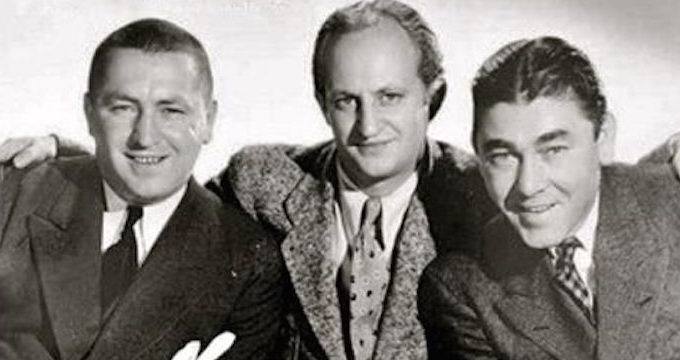
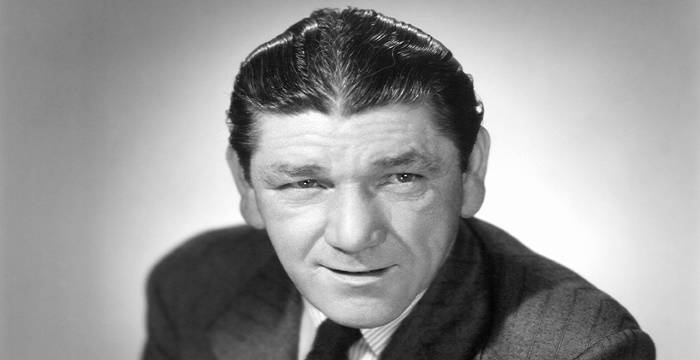

______________________________________See also: Stooges Behaving badly